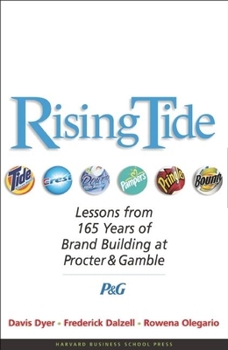Rising Tide: Lessons from 165 Years of Brand Building at Procter & Gamble
Select Format
Select Condition 
Book Overview
This work features the history of brand innovation at Procter & Gamble, one of the most successful consumer goods companies in the world. A fascinating history of household brands from Ivory to Crest, and Pringles to Cascade, this book unlocks the secrets of longtime success of dozens of superstar brands that we've grown accustomed to choosing for decades. It offers practical advice. Case study sections offer lessons in: business reinvention, building...
Format:Hardcover
Language:English
ISBN:1591391474
ISBN13:9781591391470
Release Date:July 2004
Publisher:Harvard Business Review Press
Length:467 Pages
Weight:2.01 lbs.
Dimensions:1.4" x 6.5" x 9.6"
Customer Reviews
3 ratings
A great company continues to reinvent itself
Published by Thriftbooks.com User , 15 years ago
"Rising Tide: Lessons from 165 Years of Brand Building at Procter & Gamble," by Davis Dyer, Frederick Dalzell, and Rowena Olegario, Harvard Business School Press, Boston, 2004. This 467 p. hardback tells the story of Procter & Gamble from its founding in 1837 as a candle and soap manufacturer in what was then Porkopolis, now Cincinnati. William Procter and James A. Gamble were married to sisters, Olivia and Elizabeth Ann Norris. The location proved well suited to the national market with nearby hog processing offering suitable raw materials, and access to New Orleans via the Ohio River system and the eastern seaboard via the Miami Canal completed in 1840 and the Erie Canal. Railroads soon followed. A key player in the early company was James Norris Gamble, son of the founder, who studied chemistry, undertook analysis of competitive soap products and experimented with new raw materials such as vegetable oils. As kerosene and gaslights began to replace candles, the emphasis shifted toward soap-making. One of the initial new developments was Ivory, a soap based on vegetable oils that floats. The story that it resulted from a soapmaker over cooking a batch of soap is discredited. P & G had been interested in floating soap at least since 1863. The goal was a quality soap from readily available raw materials. The Ivory name, selected from a Bible verse, was trademarked in 1879. In 1884, fire destroyed the lard oil factory. P & G took the opportunity to rebuild a modern, efficient plant, Ivorydale. It was located on the outskirts of town on a site well suited to shipment by rail. Crisco came to market in 1912, after an independent scientist, EC Kayer, approached P & G with hydrogenation technology that converted liquid oils to solid fats. As with Ivory, advertizing was used to gain acceptance in grocery stores, but working through wholesalers proved cumbersome. P & G began the switch to direct marketing to retailers in 1910. A fierce battle with jobbers resulted. Sales did not recover until 1926. Market research and brand management concepts had been adopted by 1925. Soap operas evolved in radio advertizing in 1933. Another major development was Tide, a very successful laundry detergent with much improved cleaning power. The first synthetic detergents came out of World War I Germany, where fats used to make munitions were in short supply. The first detergent using this technology, Dreft, appeared in 1932, but high performance cleaning awaited the development of phosphate builders. Tide was ready for market in 1946. As manufacturers struggled to supply ingredients, the product was gradually introduced in regions. Cleaning was so superior that customers called demanding the product before it could be supplied. Tide rapidly captured 30% market share and has remained the leader ever since. An array of additions followed World War II. They included Spic and Span (acquired 1945), Joy (1949), Cheer (1952), Dash (1954),
Good and Fast
Published by Thriftbooks.com User , 16 years ago
The book is excellent for those who really want to know about the strategy of a giant such as P & G. For me, it was particularly useful since I'm writing my disertation thesis on this and the book was exactly what I needed.
SLICK CORPORATE NOSTALGIA FROM THE 'IVORY' TOWER
Published by Thriftbooks.com User , 20 years ago
Little needs to be said for an account, any account, much less a peppy one that reads like a veritable 'soap' opera, of a company that spends close to US$ 5 billion p.a. on advertising alone. It is by definition a must-read for anyone even on the periphery of the marketing industry, and Yours Truly can vouch for the insightful trivia you'll pick up along the way if you hang your shingle in the media circles. But the sheer strategic sweep that the authors have packed into this treatise on what kept Ivory afloat (beyond watery puns) will make it a worthwhile read for just about anyone in business. The singular most significant take-away being the allocation of media budgets a century ago versus how things stand today. Interesting thoughts and riveting reminiscences wrapped in sprightly prose. Recommended in a blink.






